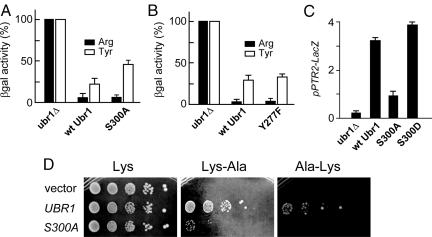Fig. 4.
Functional consequences of Ubr1 alterations at position 300. (A) Relative levels of Arg-βgal (filled bars) and Tyr-βgal (white bars), a type-1 and a type-2 N-end rule substrate, respectively (Fig. 1A), in ubr1Δ S. cerevisiae or in the same strain that expressed either wild-type Ubr1 or Ubr1S300A. (B) Same as in A but an independent experiment, and Ubr1Y277F instead of Ubr1S300A. (C) Effects of Ubr1 mutations at position 300 on PTR2 expression. S. cerevisiae JD55 (ubr1Δ) carried pSS4 (PPTR2-lacZ) and either pCH100 (wild-type Ubr1), pCH114 (Ubr1S300A) pCH246 (Ubr1S300D). Cultures were grown to A600 of ≈0.8 at 30 °C in SC containing a mixture of compounds (including amino acids) required by a strain, followed by measurements of βgal activity in cell extracts. (D) JD55 (ubr1Δ) S. cerevisiae carrying either the empty vector (pRS315), or pCH100 (wild-type Ubr1), or pCH114 (Ubr1S300A) (Table S2) were serially diluted 5-fold and spotted on SC(-Leu, -Lys) plates containing 110 μM Lys, or 66 μM Lys-Ala, or 66 μM Ala-Lys. The plates were incubated at 30 °C for 3 days.

